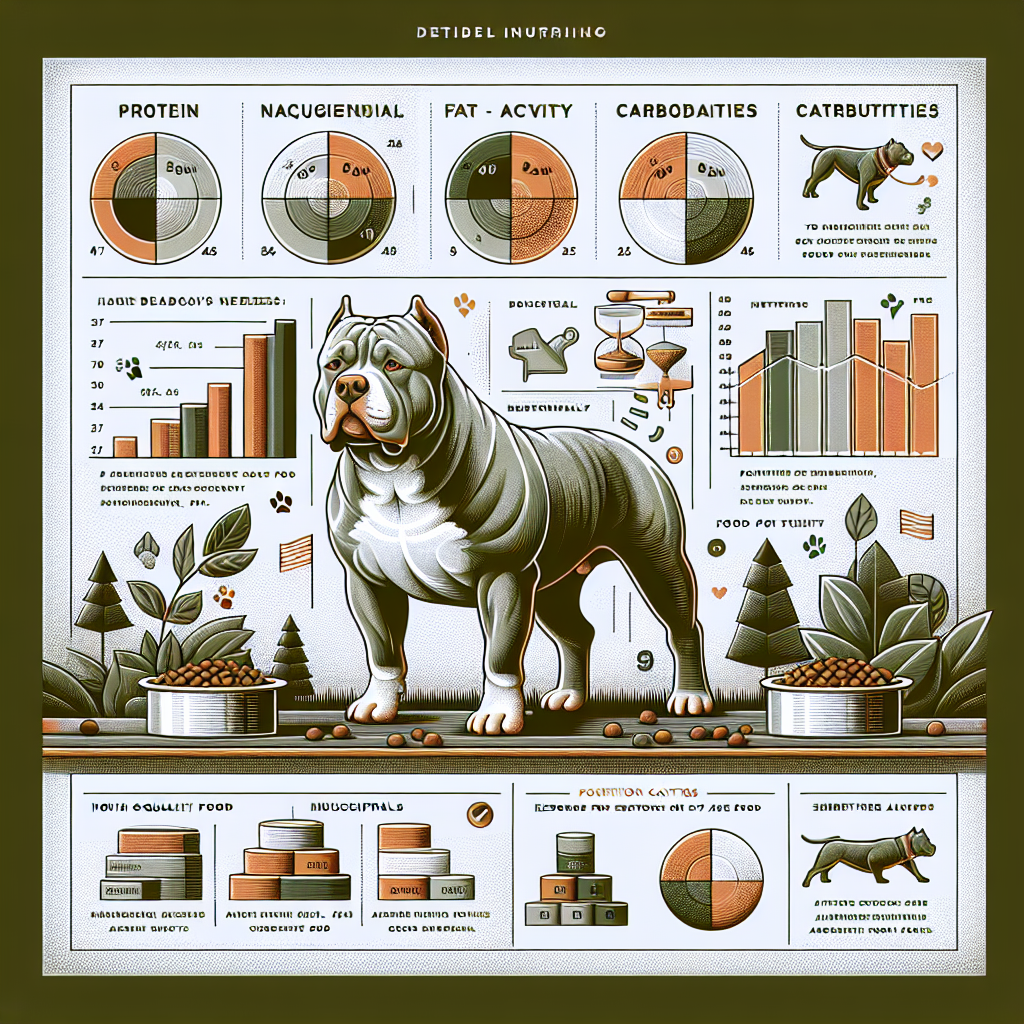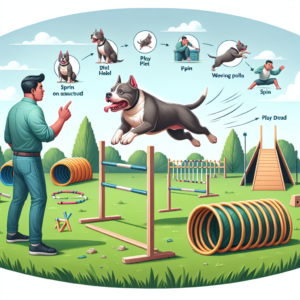Contents
- 1 A Healthy, Balanced Diet for Your American Bully
- 1.1 Introduction: The Importance of Providing a Balanced and Nutritious Diet for American Bully Dogs
- 1.2 Dietary Requirements
- 1.3 Age-Appropriate Diets and Breed-Specific Considerations
- 1.4 Portion Control
- 1.5 Choosing High-Quality Dog Food
- 1.6 Special Dietary Considerations
- 1.7 Conclusion
- 1.8 Linda Harmon
A Healthy, Balanced Diet for Your American Bully
A healthy, balanced diet is essential for your American Bully to thrive. Known for their muscular build, strong presence, and energetic personality, American Bullies require specific nutrients to maintain their physique, energy levels, and overall health. In this comprehensive guide, we’ll dive into the dietary needs of the American Bully, portion control tips, how to choose high-quality dog food, and special dietary considerations to ensure your dog’s nutrition is well-rounded and appropriate for their specific requirements.
Introduction: The Importance of Providing a Balanced and Nutritious Diet for American Bully Dogs
Just like any other breed, the American Bully requires a diet that supports its growth, energy needs, and long-term health. Feeding your dog a high-quality, balanced diet ensures they receive the right amount of nutrients at every stage of their life. Proper nutrition not only supports your dog’s muscle mass and energy levels but also helps to maintain healthy skin, coat, and digestion. By understanding the unique dietary needs of the breed, you can keep your American Bully in peak health, prevent obesity, and reduce the risk of diet-related health issues.
Dietary Requirements
Protein Needs for American Bullies
American Bullies are a muscular breed, and as such, they require a protein-rich diet to maintain their muscle mass and support growth. Protein is essential for tissue repair, immune function, and energy production. For an American Bully, the ideal protein content in their diet should range from 20% to 30% of their daily intake. High-quality animal proteins, such as chicken, beef, lamb, or fish, are optimal for promoting lean muscle development.
- Puppies: Young American Bullies require a higher protein content to support their rapid growth. Look for puppy formulas with protein levels around 25% to 30%.
- Adults: For adult American Bullies, protein content in the range of 20% to 25% is generally appropriate. Depending on their activity level and muscle mass, the protein level may be adjusted slightly.
- Seniors: Older American Bullies, especially those with reduced activity levels, may benefit from a moderate protein level (around 20%) to maintain muscle tone without putting unnecessary strain on their kidneys.
Fat Requirements
Fat is another essential nutrient for American Bullies, as it provides concentrated energy and supports healthy skin and coat. For adult dogs, fat content should make up around 8% to 15% of their daily intake, though this may vary based on their activity levels. Puppies and active adult dogs may benefit from a slightly higher fat content (up to 20%), as fat provides the energy needed for exercise and muscle development.
Carbohydrates and Fiber
Carbohydrates serve as a source of energy and aid in digestion. For American Bullies, a balanced diet should include a moderate amount of digestible carbohydrates, such as sweet potatoes, brown rice, or oatmeal. These carbs are easily digestible and provide essential vitamins and minerals. The recommended carbohydrate content should range from 30% to 50%, depending on the dog’s size, activity level, and age.
Fiber is also crucial for digestive health, helping to prevent constipation and support healthy bowel movements. High-quality fiber sources include vegetables such as pumpkin, peas, and carrots, as well as grains like barley and oats.
Age-Appropriate Diets and Breed-Specific Considerations
American Bullies’ dietary needs vary depending on their age, activity level, and health status. Feeding your dog an age-appropriate diet ensures that they get the right balance of nutrients for their life stage.
- Puppies: Puppy formulas are typically higher in protein and fat to support rapid growth and development. These diets often include extra calcium and phosphorus to support bone growth. American Bully puppies should be fed a diet formulated for large-breed puppies, as this ensures controlled growth and reduces the risk of joint issues later in life.
- Adults: Adult American Bullies should be fed a balanced diet to maintain healthy weight, muscle mass, and energy. Look for adult dog formulas that include moderate protein, fat, and carbohydrates.
- Seniors: Older American Bullies may require a diet that is lower in calories and fat but higher in fiber to support digestion and prevent weight gain. Senior formulas often contain joint-supporting nutrients like glucosamine and chondroitin to help with mobility.
Portion Control
Determining the Right Portion Size
Portion control is essential to ensure your American Bully maintains a healthy weight. Overfeeding can lead to obesity, which is particularly problematic for this breed, as it puts unnecessary strain on their joints and can contribute to health problems like heart disease and diabetes.
The appropriate portion size for your American Bully depends on several factors, including:
- Age: Puppies and young dogs generally require more calories per pound of body weight to support growth. Adult dogs need fewer calories, while senior dogs may require even fewer due to reduced activity levels.
- Weight and Body Condition: Your dog’s ideal weight should be based on their body condition. You should be able to feel their ribs without excessive fat covering. Overweight dogs may require a calorie-reduced diet, while underweight dogs may need extra calories to reach a healthy weight.
- Activity Level: Highly active American Bullies will require more food to fuel their activity, while less active dogs may need fewer calories to maintain their weight.
Signs of Overfeeding and Weight Gain
It can be tempting to feed your dog extra treats or larger portions, but overfeeding can lead to obesity. Watch for the following signs that your American Bully may be gaining excess weight:
- Difficulty feeling their ribs without applying firm pressure
- Decreased energy or reluctance to exercise
- Increased body fat, particularly around the abdomen
- Decreased mobility or joint stiffness
If you notice these signs, consider reducing portion sizes or switching to a lower-calorie dog food. It is also important to consult your veterinarian for advice on achieving a healthy weight for your dog.
Choosing High-Quality Dog Food
Reading Dog Food Labels
When selecting food for your American Bully, always choose high-quality, reputable brands that provide balanced nutrition. Understanding how to read dog food labels is essential to ensure you’re providing the best possible nutrition. The key things to look for include:
- Protein Source: The first ingredient should be a named animal protein, such as chicken, beef, or lamb. Avoid foods that list generic terms like “meat” or “poultry by-product.”
- Fat Content: Ensure that the fat content is appropriate for your dog’s life stage and activity level. Look for healthy fat sources like chicken fat, fish oil, or flaxseed.
- Grains and Vegetables: High-quality carbohydrates, such as sweet potatoes, brown rice, or barley, should be included in the formula. Avoid foods with excessive fillers like corn or soy.
- Supplements: Check for added supplements like omega fatty acids, glucosamine, chondroitin, and probiotics. These can contribute to skin health, joint mobility, and digestion.
Consulting with a Veterinarian or Nutritionist
Consulting a veterinarian or canine nutritionist is a great way to ensure you’re feeding your American Bully the right diet. They can help you develop a customized feeding plan that considers your dog’s age, health status, and activity level. Additionally, they can recommend specific brands or formulations that are tailored to your dog’s needs.
Special Dietary Considerations
Managing Allergies and Sensitivities
Some American Bullies may have food allergies or sensitivities, which can lead to digestive issues, skin problems, or ear infections. Common allergens for this breed include beef, chicken, grains, and dairy. If you suspect your dog has a food allergy, consult your veterinarian for guidance on eliminating allergens from their diet and switching to hypoallergenic food formulas.
Transitioning to a New Diet
If you need to transition your American Bully to a new diet, it’s essential to do so gradually to avoid gastrointestinal upset. Start by mixing a small amount of the new food with their current food and gradually increase the proportion over a period of 7 to 10 days. This allows their digestive system to adjust without causing discomfort.
Managing Weight Issues
If your American Bully is overweight, reducing their calorie intake and increasing exercise can help them shed excess pounds. Consult your veterinarian for specific dietary recommendations and to rule out underlying health issues, such as hypothyroidism, that could be contributing to weight gain.
Conclusion
Feeding your American Bully the right diet is critical to their overall health, longevity, and happiness. By understanding their nutritional needs, practicing portion control, and selecting high-quality food, you can ensure that your dog stays fit, healthy, and full of energy. Whether you’re addressing specific dietary restrictions or transitioning to a new diet, always consult with a veterinarian to ensure you’re providing the best care possible for your furry friend.


